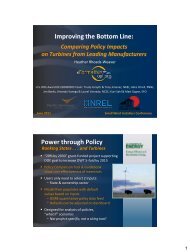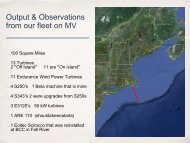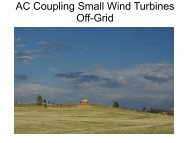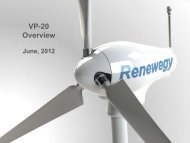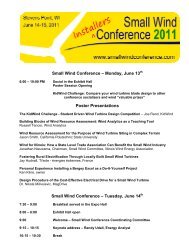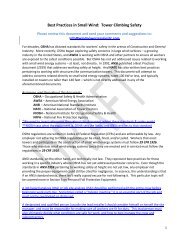James Knickelbine And Charles Sontag, Woodland Dunes Nature
James Knickelbine And Charles Sontag, Woodland Dunes Nature
James Knickelbine And Charles Sontag, Woodland Dunes Nature
You also want an ePaper? Increase the reach of your titles
YUMPU automatically turns print PDFs into web optimized ePapers that Google loves.
<strong>James</strong> <strong>Knickelbine</strong> and <strong>Charles</strong> <strong>Sontag</strong>, <strong>Woodland</strong><strong>Dunes</strong> <strong>Nature</strong> Center and Preserve, Two Rivers,Wisconsin
In fall 2010 and spring 2011 the areas around two smallwind turbines at Orion Energy Systems were studied. Onnearly all mornings during those peak migration periods,<strong>Woodland</strong> <strong>Dunes</strong> staff and volunteers searched for birdand bat carcasses beneath the turbines, and also beneathnearby windows on Orion’s office building for comparison.Searcher efficiency and rates of carcass removal byscavengers were also measured. Five bird carcasses werefound beneath the turbines, and twenty-three carcasseswere found under the windows. No bat carcasses werefound.
•Orion Energy Systems- permission to studytheir property•Dr. Robert Howe- UW- Green Bay•Wisconsin DNR- assistance and informationfrom various staff•City of Manitowoc Plan Commissionrecognizingour interest in the wind turbineproject•Board of Directors, volunteers, and staff of<strong>Woodland</strong> <strong>Dunes</strong> <strong>Nature</strong> Center
Background-• <strong>Woodland</strong> <strong>Dunes</strong> is a non-profit nature preserveand environmental education center.• Founded in 1974 by bird researchers and othersinterested in preserving wooded habitat betweenManitowoc and Two Rivers. About 1,200 acrespurchased, preserved, and managed to date.• Ongoing research- more than 25,000 birds have beencaught, banded, and released, and data on as manysummer resident birds collected.• Education- about 90,000 school children have visited<strong>Woodland</strong> <strong>Dunes</strong> for education programs.
<strong>Woodland</strong> <strong>Dunes</strong>•State Natural Area•Important Bird Area•Designated one of 100 Wetland Gems•Ice Age Trail partner•Lake Michigan Birding and <strong>Nature</strong>Trail stop
Orion Energy Systems•An innovative company whichmanufactures energy-saving lightingcomponents and whose interests alsoinclude sustainable energy productsutilizing energy harvested from solarand wind sources.
Globally important habitat locatedon bird migration corridor
A closer look…
Background cont’d• Birds face many hazards caused by people, especially tallstructures including buildings and communication towers,transportation, and outdoor cats. All of those exist around/in<strong>Woodland</strong> <strong>Dunes</strong>.• Annual Bird Mortality(US) Estimates (Erickson, lit. review 2005)• Buildings550 million• Power Lines130 million• Cats100 million• Automobiles80 million• Pesticides67 million• Communication towers4.5 million• Wind turbines28.5 thousand• Airplanes25 thousand
Purpose of Study•To attempt to assess the degree towhich the presence of two small windturbines near the <strong>Woodland</strong> <strong>Dunes</strong>Preserve results in bird and batmortality.
Background• Orion came to <strong>Woodland</strong> <strong>Dunes</strong> to discuss futureplans to construct two wind turbines across the roadfrom the preserve.• Review of available research indicated low birdmortality reported in general, but no studies on GreatLakes.• <strong>Woodland</strong> <strong>Dunes</strong> proposed to Orion that the site bestudied, and Orion consents.• First turbine constructed August 2010, study begins inSeptember. Second turbine constructed during studyperiod, partial search area there included in study.
naturepreserveLake Michigan
Orion Energy SystemsLarge turbineSmall turbine
Study Methods• Baseline resident birds measured, summer.• Search areas determined, circle radius= turbine height• Partial search area for large turbine- wetland, woods tonorth hampered searching.• Areas searched daily in the morning during peak migration• Trials were conducted to evaluate searcher efficiency andrates of carcass removal by scavengers.
Number of Birdsalder flycatcherAmerican crowAmerican goldfinchAmerican redstartAmerican robinbaltimore oriolebarn swallowblack-capped chickadeeblue jaybrown-headed cowbirdcanada goosecedar waxwingchimney swiftcommon gracklecommon terncommon yellowthroateastern kingbirdeastern meadowlarkeastern towheeeuropean starlinggray catbirdgreat crested flycatchergull sp.herring gullhouse wrenindigo buntingkilldeerleast flycatchermallardmourning dovenorthern waterthrushpurple martinred-eyed vireored-winged blackbirdring-billed gullrock pigeonrough-winged swallowsong sparrowtree swallowturkey vulturewarbling vireoyellow warbleryellow shafted flickerNesting Season Survey7060Orion Summer Bird Survey5040302010Series10Species• Forty-three species, 242 birds
Songbirds Banded, study period• 426 birds of 44 species, not including >300 saw-whet owls
Small TurbineTurbine installed August2010.Turbine 115 feet tall, ratedat 20kW
Search Area
Search Area
LargeTurbine167 ft. tall50 kW
Search Area- building windows
Results-• Fall 2010- one bird carcass was found under eachturbine.• Spring 2011- two birds found at small turbine, one atlarge turbine. One additional bird was found in thesearch area that had died before the study began.• Fall- Fifteen bird carcasses were found under thewindows, spring- eight carcasses.• No bats were found in either season.
Cumulative Number of Birds Found2520151050small turbine large turbine windows
Bird Species at TurbinesOrange-crowned WarblerNorthern CardinalChipping SparrowEmpid.FlycatcherBrownCreeper
Bird Species at WindowsCanadaWarblerRuby-throatedHummingbirdSwainson’s ThrushRuby-crowned KingletYellow-rumped WarblerBlack and White Warbler
Scavenger Removal• Five bird carcasses placed or left within the search areaon two occasions.• First trial: after four days two carcasses had beenremoved. Others remained for duration of study,more than one month.• Second trial, five carcasses were placed, none had beenremoved after 24 hours.• In Spring, carcasses remained on site from 1 to 14 days.
Number of carcasses remaining65Scavenger Carcass Removal43210date
Searcher Efficiency• Two trials• In one trial, carcasses placed by staff member notinvolved in the study. Searchers then searched thesmall turbine area as usual.• Searches found 60% of the placed songbirds
Discussion• Results still considered preliminary, only twomigration periods studied. Orion has givenpermission to continue the study.• Possible factors influencing low bird numbers atturbines:• Turbines are less than 200 feet tall• Towers tubular, not lattice-type• Turbines are unlighted- lights can attract birds duringnight migration• Winds were often calm at night, turbines not moving
• Weather data for week of Sept. 13 (weatherunderground.com)
Conclusions• Most studies compensate forscavenging/searcher efficiency byestimating actual number of birds killed asbeing 2-5 times the number that are found.Using that, at this point we estimate thenumber of birds killed at 10-25 per year atthe tubines, and 46-115 per year at thewindows.
Recommendations• Continue study during migration periods- look forfunding support.• Increase bat surveillance• Continue to monitor other research being done.
Recommendation• Better aerobic training forsearchers so they can avoidthe wrath of the Black Swan !!
•Orion Energy Systems- Michael Potts and Bob Rutten•Dick LuchsingerContact: Jim <strong>Knickelbine</strong>, nature@woodlanddunes.org<strong>Woodland</strong> <strong>Dunes</strong> <strong>Nature</strong> Center and Preservewoodlanddunes.org





